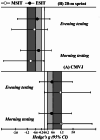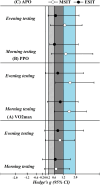Morning sprint interval training produces greater physical performance adaptations than evening training in soccer players
- PMID: 39979557
- PMCID: PMC11842626
- DOI: 10.1038/s41598-025-89821-4
Morning sprint interval training produces greater physical performance adaptations than evening training in soccer players
Abstract
While the literature provides evidence supporting the effectiveness of evening sprint interval training (SIT), there remains a limited amount of research investigating the effects of morning SIT among soccer athletes. This study examined the effects of morning versus evening SIT during the preparatory phase on physical and physiological performance in collegiate soccer players. Thirty male players volunteered to participate in the study and were randomly divided into morning, evening, or control groups, each group consisting of 10 subjects. The evaluation of physical (countermovement vertical jump [CMVJ], 20-m sprint, Illinois change of direction, and Yo-Yo intermittent recovery test level 1 [Yo-Yo IR1]) and physiological (graded exercise test and Wingate anaerobic power test) performance took place prior to and following the 7-week SIT, both in the morning and evening testing sessions. Both training groups showed significant improvements in physical and physiological performance from pre- to post-training, regardless of testing session timing (p < 0.05). The morning SIT group exhibited greater adaptive changes (p < 0.05) compared to the evening SIT group in CMVJ, 20-m sprint, Yo-Yo IR1, peak and mean power outputs at both the morning and evening testing sessions. These findings suggest that male soccer players can benefit from both morning and evening SIT sessions; however, conducting SIT in the morning could result in greater adaptive changes than evening training. To optimize physical performance adaptations, coaches should schedule SIT sessions in the morning. It is recommended to schedule conditioning workouts in the morning and team practices in the afternoon for optimal adaptations.
Keywords: Aerobic power; Anaerobic power; Athletic performance; Interval training; Team sport.
© 2025. The Author(s).
Conflict of interest statement
Declarations. Competing interests: The authors declare no competing interests.
Figures



Similar articles
-
The Effects of a 6-Week Plyometric and Sprint Interval Training Intervention on Soccer Player's Physical Performance.J Sports Sci Med. 2024 Sep 1;23(1):526-536. doi: 10.52082/jssm.2024.526. eCollection 2024 Sep. J Sports Sci Med. 2024. PMID: 39228777 Free PMC article. Clinical Trial.
-
Optimizing Short Sprint Interval Training for Young Soccer Players: Unveiling Optimal Rest Distributions to Maximize Physiological Adaptations.J Sports Sci Med. 2024 Jun 1;23(2):475-486. doi: 10.52082/jssm.2024.475. eCollection 2024 Jun. J Sports Sci Med. 2024. PMID: 38841640 Free PMC article. Clinical Trial.
-
In-season adaptations to intense intermittent training and sprint interval training in sub-elite football players.Scand J Med Sci Sports. 2019 May;29(5):669-677. doi: 10.1111/sms.13395. Epub 2019 Feb 17. Scand J Med Sci Sports. 2019. PMID: 30676666 Clinical Trial.
-
Physiological and Biochemical Adaptations to a Sport-Specific Sprint Interval Training in Male Basketball Athletes.J Sports Sci Med. 2023 Dec 1;22(4):605-613. doi: 10.52082/jssm.2023.605. eCollection 2023 Dec. J Sports Sci Med. 2023. PMID: 38045752 Free PMC article.
-
Physiological and Performance Adaptations to Running-Based Interval Interventions in Soccer Players: Comparative Analysis of Sprint Interval Training, Small-Sided Games, and Repeated-Sprint Training.Int J Sports Physiol Perform. 2025 Sep 1:1-9. doi: 10.1123/ijspp.2025-0168. Online ahead of print. Int J Sports Physiol Perform. 2025. PMID: 40897346
References
-
- Helgerud, J., Engen, L. C., Wisløff, U. & Hoff, J. A. N. aerobic endurance training improves soccer performance. Med. Sci. Sports Exerc.33 (11), 1925–1931 (2001). - PubMed
-
- Reilly, T. Physiological aspects of soccer. Biol. Sport. 11, 3–20 (1994).
Publication types
MeSH terms
LinkOut - more resources
Full Text Sources

